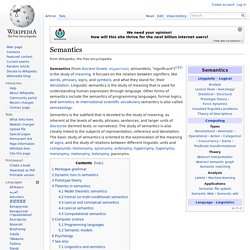

Semantic web. 3.0 Semantic Web. Semantic technologies. DBpedia. DBpedia ( from "DB" for "database" ) is a project aiming to extract structured content from the information created as part of the Wikipedia project.

This structured information is then made available on the World Wide Web.[1] DBpedia allows users to query relationships and properties associated with Wikipedia resources, including links to other related datasets.[2] DBpedia has been described by Tim Berners-Lee as one of the more famous parts of the decentralized Linked Data effort.[3] Background[edit] The project was started by people at the Free University of Berlin and the University of Leipzig, in collaboration with OpenLink Software,[4] and the first publicly available dataset was published in 2007. It is made available under free licences, allowing others to reuse the dataset. Dataset[edit] From this dataset, information spread across multiple pages can be extracted, for example book authorship can be put together from pages about the work, or the author.
Examples[edit] Use cases[edit] Semantics. Montague grammar[edit] In the late 1960s, Richard Montague proposed a system for defining semantic entries in the lexicon in terms of the lambda calculus.

In these terms, the syntactic parse of the sentence John ate every bagel would consist of a subject (John) and a predicate (ate every bagel); Montague demonstrated that the meaning of the sentence altogether could be decomposed into the meanings of its parts and in relatively few rules of combination. The logical predicate thus obtained would be elaborated further, e.g. using truth theory models, which ultimately relate meanings to a set of Tarskiian universals, which may lie outside the logic. The notion of such meaning atoms or primitives is basic to the language of thought hypothesis from the 1970s. Despite its elegance, Montague grammar was limited by the context-dependent variability in word sense, and led to several attempts at incorporating context, such as: Dynamic turn in semantics[edit] Prototype theory[edit] SPARQL. SPARQL (pronounced "sparkle", a recursive acronym for SPARQL Protocol and RDF Query Language) is an RDF query language, that is, a semantic query language for databases, able to retrieve and manipulate data stored in Resource Description Framework format.[2][3] It was made a standard by the RDF Data Access Working Group (DAWG) of the World Wide Web Consortium, and is recognized as one of the key technologies of the semantic web.

On 15 January 2008, SPARQL 1.0 became an official W3C Recommendation,[4][5] and SPARQL 1.1 in March, 2013.[6] SPARQL allows for a query to consist of triple patterns, conjunctions, disjunctions, and optional patterns.[7] Implementations for multiple programming languages exist.[8] "SPARQL will make a huge difference" making the web machine-readable according to Sir Tim Berners-Lee in a May 2006 interview.[9] Advantages[edit] The example below demonstrates a simple query that leverages the ontology definition "foaf", often called the "friend-of-a-friend" ontology.